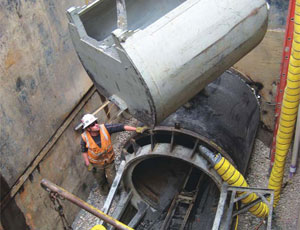Aurora is taking a big step to keep itself from becoming a dry city.
Water levels in Aurora reservoirs sank to within 26% of empty during the drought year of 2002, a critical level the city is unlikely to suffer again, even in dry spells.


Led by former Director Peter D. Binney, Aurora Water quickly responded to the most recent drought by launching the ambitious Prairie Waters project to capture water it already owns by virtue of long-standing water rights on the South Platte River. Once recovered, the water will be transported to an advanced purification facility north of Aurora Reservoir.
Prairie Waters, part of a $1.1-billion, 10-year capital improvement project to reinforce the reliability of Aurora’s water system, adds 3.3 billion gal. (10,000 acre-ft) annually to the city’s water supply—a 20% increase. “This idea brings Colorado’s most valuable resource—water—to Aurora’s most valuable asset, our residents,” Aurora Mayor Ed Tauer says. The project is designed to meet Aurora’s water needs through 2020.
Long and Winding Road Water collected by 17 high-capacity alluvial wells drilled by Garney Construction, Littleton, Colo., within 200 yd of the banks of the South Platte River in Weld County is sent first to the North Campus aquifer-recharge-and-recovery basin, then, via 34 miles of pipeline and three pump stations, to the Peter D. Binney Purification Facility. Finally, purified water is transferred from Binney to the Robertsdale Tank and Pump Station for distribution to residential customers.
Binney and Robertsdale are located adjacent to each other on the same site immediately north of Aurora Reservoir near the corner of Powhaton Road and E. Quincy Avenue.
CH2M Hill of Denver designed the North Campus and managed the overall project. MWH Americas Inc., Denver, designed the conveyance system (pipeline), and Brown & Caldwell, Golden, the Robertsdale Tank & Pump Station.
The pipeline was laid in three segments: Segment 1, 68,830 ft, by Reynolds-Tierdael, Denver; Segment 2, 46,566 ft, by S.J. Louis Construction of Texas Ltd; and Segment 3, 49,368 ft, by Garney Construction Inc. Portions of two segments parallel a 14-mile stretch of E-470. Garney Construction built North Campus and Robertsdale; Western Summit Constructors, Denver, did Binney.
Design work began in August 2005, construction in 2007. Construction is expected to wrap up in April, followed by a requisite six-month startup and testing period.
Budgeted for $754.8 million, the Prairie Waters Project will come in well under that figure and be fully operational by October 2010, nearly three months ahead of the scheduled December completion date.
“The $754.8-million figure represents a value-engineering effort that shaved $100 million off our initial budget,” says Dave Marciniak, public involvement representative with Aurora Water. “Included in that figure is a $75-million loan from the Colorado Conservation Board. Other than that, just $426 million in bonds were sold to ensure that any debt incurred would not run higher than absolutely necessary.”
Well Water Marciniak adds that “water collected by the source wells is not South Platte water per se” but naturally...



Post a comment to this article
Report Abusive Comment